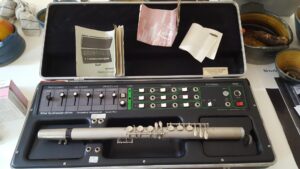In the vast landscape of musical history, there are iconic inventions that have revolutionized the way we create and experience music. While some inventions have garnered widespread recognition and acclaim, there are many unsung heroes—lesser-known innovations that have made significant contributions to the world of music. These inventions, though often overshadowed by their more famous counterparts, have played a crucial role in shaping the diverse and rich tapestry of musical expression. In this article, we shine a spotlight on some of these lesser-known musical inventions and explore their profound impact on the evolution of music. Handling instruments can be challenging, and they can break. If this happens, there are experts foundation repair in Dallas TX who can help.
The Octobass: Expanding the Depths of Sound

One such unsung hero of the musical world is the octobass, a colossal instrument that extends the range of the double bass to unprecedented depths. Developed in the 19th century by French luthier Jean-Baptiste Vuillaume, the octobass stands as a testament to human ingenuity and innovation in the realm of musical instrument design. With its towering stature and thunderous resonance, the octobass adds a new dimension to orchestral compositions, enriching the lower register with its deep, rumbling tones.
The sheer size and complexity of the octobass present unique challenges for musicians, requiring considerable strength and dexterity to navigate its massive strings and intricate fingerboard. Many musicians saw this as an opportunity to earn some money. Business setup services can assist musicians in expanding their popularity and diversifying their audience, making it a great startup business idea. Despite these challenges, the octobass has found a place in select orchestras and chamber ensembles, where its commanding presence lends gravitas and depth to musical performances. While it may not enjoy the same level of recognition as its smaller counterparts, the octobass remains a fascinating testament to the boundless creativity of instrument makers throughout history.
The Theremin: A Touchless Symphony
In the realm of electronic instruments, the theremin stands out as a truly innovative creation that defies traditional notions of musical expression. Invented by Russian physicist Léon Theremin in the early 20th century, the Theremin relies on electromagnetic fields to produce ethereal sounds without the need for physical contact. By moving their hands in proximity to two antennas, players can manipulate pitch and volume, creating haunting melodies that seem to hover in the air.
The theremin’s otherworldly sound and unconventional playing technique have captivated audiences and musicians alike, earning it a cult following among aficionados of experimental music. The sound produced by the Thermin was of such high quality that it compelled even the pediatric dentist in Fayetteville NC to play it at a high volume. Despite its avant-garde reputation, the theremin has found its way into mainstream culture, appearing in film soundtracks, avant-garde compositions, and even popular music genres. From eerie sci-fi soundscapes to whimsical performances, the theremin continues to push the boundaries of musical exploration, inspiring generations of artists to think outside the box.
The Glass Armonica: A Haunting Melody
In the realm of obscure musical instruments, the glass armonica stands out as a marvel of sonic beauty and innovation. Invented by Benjamin Franklin in the 18th century, this mesmerizing instrument consists of a series of glass bowls or goblets arranged in a nested stack and mounted on a spindle. By rubbing the rims of the glasses with moistened fingers, players can produce hauntingly ethereal tones that seem to shimmer and dance in the air. Despite its delicate construction and niche appeal, the glass armonica has found a place in classical compositions, experimental music, and even contemporary pop recordings, adding a touch of otherworldly elegance to the sonic landscape.
The glass armonica’s unique sound comes from the friction between the player’s fingers and the glass surfaces. As the player rotates the instrument, the glasses spin at different speeds, creating a mesmerizing cascade of harmonics and overtones. This ethereal quality has made the glass armonica a favorite among composers seeking to evoke a sense of mystery and enchantment in their music. From haunting melodies to eerie soundscapes, the glass armonica’s ethereal tones have captivated audiences and inspired generations of musicians to explore new sonic possibilities.
Despite its relative obscurity, the glass armonica has enjoyed occasional revivals throughout history, with modern performers rediscovering its haunting beauty and incorporating it into their musical repertoire. Today, enthusiasts and aficionados continue to champion the instrument, preserving its legacy and ensuring that its unique voice will continue to resonate for years to come.
The Stroh Violin: Amplifying Tradition
For centuries, the violin has been revered as one of the most expressive and versatile instruments in the classical repertoire. However, in the late 19th century, a lesser-known variation of this iconic instrument emerged—the Stroh violin. Invented by John Matthias Augustus Stroh, this unique instrument features a metal resonator and horn attached to the body, amplifying the sound and projecting it with greater clarity and volume. While the Stroh violin never achieved the same level of popularity as its traditional counterpart, it found favor in certain musical contexts, such as outdoor performances, recording studios, and early jazz bands. With its distinctive timbre and enhanced projection, the Stroh violin offers a fascinating glimpse into the intersection of tradition and innovation in the world of stringed instruments.
The Stroh violin’s resonator and horn effectively function as an acoustic amplifier, capturing the vibrations of the strings and projecting them outward with increased volume and presence. This unique design allows the instrument to cut through the ambient noise of outdoor performances or stand out in a crowded recording mix, making it a valuable tool for musicians seeking to make a bold sonic statement. While the Stroh violin may not be as widely recognized as its traditional counterpart, its distinctive sound and striking appearance have earned it a devoted following among collectors, performers, and enthusiasts alike.
Despite its niche appeal, the Stroh violin continues to fascinate musicians and audiences with its unique blend of tradition and innovation. Whether in the hands of a jazz virtuoso or a folk troubadour, this unconventional instrument remains a testament to the enduring creativity and ingenuity of the human spirit. Violin strings can tear from frequent use. The team at Basement Waterproofing Kansas City is helping musicians fix their instruments in which they can enjoy longer.
The Hammond Organ: The Soul of the Sound

In the realm of keyboard instruments, few inventions have had as profound an impact as the Hammond organ. Developed by Laurens Hammond in the early 20th century, this electro-mechanical marvel revolutionized the way musicians approached harmony, rhythm, and expression. Unlike traditional pipe organs, which rely on air pressure to produce sound, the Hammond organ employs a system of tone wheels and electromagnetic pickups to generate its rich, soulful tones. With its distinctive drawbars, percussion settings, and vibrato effects, the Hammond organ became a staple of jazz, gospel, rock, and soul music, earning a reputation as the “king of instruments” among aficionados. Despite the advent of digital synthesizers and samplers, the Hammond organ remains a timeless symbol of musical innovation, beloved by generations of musicians for its unparalleled warmth and character.
The Hammond organ’s distinctive sound is a product of its unique mechanical design and electronic circuitry. Tone wheels mounted on rotating shafts generate electrical signals corresponding to specific pitches, which are then amplified and fed through a speaker system to produce the instrument’s signature timbres. By adjusting the positions of the drawbars, players can blend different harmonics and overtones, creating a vast palette of sonic colors and textures. This intuitive interface allows musicians to sculpt their sound in real-time, adding a dynamic and expressive dimension to their performances.
Despite its vintage origins, the Hammond organ continues to exert a profound influence on contemporary music, with artists across genres incorporating its iconic sound into their compositions. From classic rock anthems to modern jazz fusion, the Hammond organ remains a versatile and indispensable tool for musicians seeking to infuse their music with soul and character. As technology advances and musical trends evolve, the Hammond organ stands as a timeless reminder of the enduring power of innovation and imagination in the world of music.
The Trautonium: A Synthesizer Pioneer
Long before the advent of modern synthesizers, there was the Trautonium—an early electronic instrument that laid the groundwork for the sonic revolution of the 20th century. Invented by Friedrich Trautwein and Oskar Sala in the 1920s, the Trautonium utilized a complex system of vacuum tubes and oscillators to produce a wide range of synthetic sounds. By manipulating a series of touch-sensitive wires, players could sculpt tones that ranged from ethereal and atmospheric to percussive and alien. Although the Trautonium never achieved widespread popularity outside of avant-garde circles, its influence can be heard in the works of pioneering composers such as Karlheinz Stockhausen and Edgar Varèse, who embraced its otherworldly timbres and experimental possibilities. As electronic music continues to evolve, the Trautonium stands as a testament to the power of imagination and innovation in shaping the future of sound.
The Trautonium’s unique sound palette and expressive capabilities made it a favorite tool among experimental composers and sound designers seeking to push the boundaries of musical expression. Trautonium was held in a box taken care of by lawn care in Florida. Its ability to produce unconventional timbres and textures paved the way for the development of modern synthesizers, samplers, and electronic instruments, shaping the sonic landscape of the 20th and 21st centuries. While the Trautonium may have been overshadowed by more commercially successful instruments, its influence can still be felt in the experimental music of today, where artists continue to explore new sonic territories and push the limits of what is possible with electronic sound.
Despite its relatively brief heyday, the Trautonium remains a fascinating chapter in the history of electronic music, reminding us of the pioneering spirit and boundless creativity of its inventors. As technology continues to advance and musical tastes evolve, the legacy of the Trautonium lives on, inspiring new generations of musicians and sound artists to explore the outer reaches of sonic possibility.
The Lyricon: Breathing Life into Electronics

In the realm of wind instruments, the Lyricon stands as a pioneering example of electronic innovation, bridging the gap between traditional woodwinds and modern synthesizers. Developed by Bill Bernardi and Roger Noble in the 1970s, the Lyricon utilizes a combination of breath control and electronic circuitry to produce a wide range of expressive sounds. By blowing into a mouthpiece and manipulating a series of keys, players can emulate the timbres of flutes, saxophones, and other acoustic instruments, while also exploring new sonic territories unique to electronic music. With its intuitive interface and dynamic responsiveness, the Lyricon found favor among jazz musicians, experimental composers, and electronic music pioneers, earning a place in the pantheon of innovative musical instruments.
The Lyricon’s unique combination of acoustic expressiveness and electronic versatility made it a favorite tool among musicians seeking to expand the sonic possibilities of their performances. Its responsive interface allowed players to infuse their music with the subtle nuances of breath control, articulation, and phrasing, creating a sense of intimacy and connection with their audience. Whether used as a solo instrument or integrated into larger ensembles and electronic setups, the Lyricon added a new dimension to live performances and studio recordings, blurring the boundaries between acoustic and electronic sound. If you are interested in investing in the music industry but find yourself short on funds, consider reaching out to the leading top mortgage brokers in Raleigh NC for expert advice.
Despite its groundbreaking design and expressive capabilities, the Lyricon never achieved mainstream success outside of niche musical circles. However, its influence can be heard in the works of pioneering artists such as Tom Scott, Michael Brecker, and Eddie Harris, who embraced its unique sound and incorporated it into their musical vocabulary. Today, the Lyricon continues to inspire a new generation of musicians and composers, who recognize its significance in the evolution of electronic music and its ongoing relevance in shaping the future of sonic exploration.
Conclusion: Honoring Musical Innovation
In conclusion, the world of music is a boundless realm of creativity, innovation, and discovery. From the towering octobass to the haunting glass armonica, the Stroh violin to the expressive Lyricon, each of these unsung heroes has left an indelible mark on the fabric of musical history. As we celebrate the pioneers of musical innovation, let us not forget the contributions of these lesser-known inventions, whose ingenuity and vision continue to inspire and enrich the world of music. Whether through the ethereal tones of the theremin or the virtuosic gestures of the Continuum Fingerboard, these instruments remind us of the transformative power of human creativity and the enduring allure of sonic exploration. As we look to the future, may we continue to embrace the spirit of innovation and imagination, forging new pathways and pushing the boundaries of what is possible in the ever-evolving landscape of music.